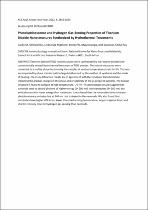 ResearchSpace
ResearchSpace
Photoluminescence and hydrogen gas-sensing properties of titanium dioxide nanostructures synthesized by hydrothermal treatments
JavaScript is disabled for your browser. Some features of this site may not work without it.
- ResearchSpace
- →
- Research Publications/Outputs
- →
- Journal Articles
- →
- View Item
| dc.contributor.author |
Sikhwivhilu, LM

|
|
| dc.contributor.author |
Mpelane, S

|
|
| dc.contributor.author |
Mwakikunga, Bonex W

|
|
| dc.contributor.author |
Ray, Suprakas S

|
|
| dc.date.accessioned | 2013-01-28T08:47:49Z | |
| dc.date.available | 2013-01-28T08:47:49Z | |
| dc.date.issued | 2012-03 | |
| dc.identifier.citation | Sikhwivhilu, L.M. et al. 2012. Photoluminescence and hydrogen gas-sensing properties of titanium dioxide nanostructures synthesized by hydrothermal treatments. ACS Applied Materials & Interfaces, vol. 4(3), pp. 1656-1665 | en_US |
| dc.identifier.issn | 1944-8244 | |
| dc.identifier.uri | http://pubs.acs.org/doi/abs/10.1021/am2018089 | |
| dc.identifier.uri | http://hdl.handle.net/10204/6473 | |
| dc.description | Copyright: 2012 ACS Publications. This is an ABSTRACT ONLY. | en_US |
| dc.description.abstract | Titanium dioxide (TiO2) nanostructures were synthesized by microwave-assisted and conventionally heated hydrothermal treatment of TiO2 powder. The tubular structures were converted to a rodlike shape by sintering the samples at various temperatures in air for 3 h. This was accompanied by phase transformation largely influenced by the method of synthesis and the mode of heating. The X-ray diffraction results are in agreement with the structural transformation indicating the gradual changes in the phase and crystallinity of the as prepared samples. The tubular structure is found to collapse at high temperature. UV-vis-IR spectroscopic results suggest that nanorods tend to absorb photons of higher energy ( = 280 nm) than nanotubes ( = 300 nm) but emit photons with lower energy than nanotubes. It was found that the nanotubes have a sharper photoluminance emission line at 340 nm that is absent in the nanorods. We also found that nanotubes have higher efficiency, lower threshold sensing temperature, longer response time, and shorter recovery time for hydrogen gas sensing than nanorods. | en_US |
| dc.language.iso | en | en_US |
| dc.publisher | ACS Publications | en_US |
| dc.relation.ispartofseries | Workflow;10125 | |
| dc.subject | Titanium dioxide nanostructure | en_US |
| dc.subject | Photoluminescence properties | en_US |
| dc.subject | Hydrogen sensing behaviors | en_US |
| dc.title | Photoluminescence and hydrogen gas-sensing properties of titanium dioxide nanostructures synthesized by hydrothermal treatments | en_US |
| dc.type | Article | en_US |
| dc.identifier.apacitation | Sikhwivhilu, L., Mpelane, S., Mwakikunga, B. W., & Ray, S. S. (2012). Photoluminescence and hydrogen gas-sensing properties of titanium dioxide nanostructures synthesized by hydrothermal treatments. http://hdl.handle.net/10204/6473 | en_ZA |
| dc.identifier.chicagocitation | Sikhwivhilu, LM, S Mpelane, Bonex W Mwakikunga, and Suprakas S Ray "Photoluminescence and hydrogen gas-sensing properties of titanium dioxide nanostructures synthesized by hydrothermal treatments." (2012) http://hdl.handle.net/10204/6473 | en_ZA |
| dc.identifier.vancouvercitation | Sikhwivhilu L, Mpelane S, Mwakikunga BW, Ray SS. Photoluminescence and hydrogen gas-sensing properties of titanium dioxide nanostructures synthesized by hydrothermal treatments. 2012; http://hdl.handle.net/10204/6473. | en_ZA |
| dc.identifier.ris | TY - Article AU - Sikhwivhilu, LM AU - Mpelane, S AU - Mwakikunga, Bonex W AU - Ray, Suprakas S AB - Titanium dioxide (TiO2) nanostructures were synthesized by microwave-assisted and conventionally heated hydrothermal treatment of TiO2 powder. The tubular structures were converted to a rodlike shape by sintering the samples at various temperatures in air for 3 h. This was accompanied by phase transformation largely influenced by the method of synthesis and the mode of heating. The X-ray diffraction results are in agreement with the structural transformation indicating the gradual changes in the phase and crystallinity of the as prepared samples. The tubular structure is found to collapse at high temperature. UV-vis-IR spectroscopic results suggest that nanorods tend to absorb photons of higher energy ( = 280 nm) than nanotubes ( = 300 nm) but emit photons with lower energy than nanotubes. It was found that the nanotubes have a sharper photoluminance emission line at 340 nm that is absent in the nanorods. We also found that nanotubes have higher efficiency, lower threshold sensing temperature, longer response time, and shorter recovery time for hydrogen gas sensing than nanorods. DA - 2012-03 DB - ResearchSpace DP - CSIR KW - Titanium dioxide nanostructure KW - Photoluminescence properties KW - Hydrogen sensing behaviors LK - https://researchspace.csir.co.za PY - 2012 SM - 1944-8244 T1 - Photoluminescence and hydrogen gas-sensing properties of titanium dioxide nanostructures synthesized by hydrothermal treatments TI - Photoluminescence and hydrogen gas-sensing properties of titanium dioxide nanostructures synthesized by hydrothermal treatments UR - http://hdl.handle.net/10204/6473 ER - | en_ZA |





